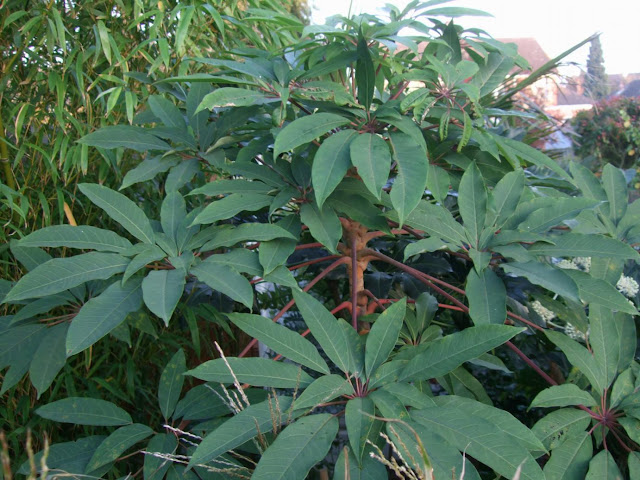Wednesday, December 05, 2012
Mark and Gaz
One thing we sometimes get asked is what happens to all our exotic plants over winter and how do they cope with the snow and the cold?
The first thing to remember is that not all of our plants come from tropical locations, an exotic plant by definition is one that is not native, however like many others we use the word to conjure up the image of the tropics. Only some of our plants are actually tropical, many are unusual or hardy relatives of tropical plants or simply hardy plants that help create a feeling when grouped with other plants.
Of course we do grow a number of tender tropicals, and for the small number of these plants, there are warm places for them to get tucked away into, such as our two greenhouses which are heated, the "exotic shed" Mark mentioned in this post, or even the house (see the photos here of our kitchen from 2010). But for the majority of plants they just have to get on with things out in the garden, taking the snow frost and cold in their stride.
 |
Cycas revoluta, reasonably hardy, however we keep these in pots and move them if very bad
weather is expected. But for the majority of winter they stay outside. Last year they were moved
under cover for just a couple of weeks or so. |
 |
| And the cycad with the recent snow... |
Plants that are truly tropical would not cope with such weather, for example coconut palms, which immediately make you think of tropical beaches, quite simply would not grow in the UK. So instead of using tropical plants we use plants that look tropical but in fact are often far from it.
One of the hardiest palms that will grow in the UK is Trachycarus fortunei. This is very tough, with some reports indicating it can survive well below -20C (the worst we have ever had is -10C). It is tolerant of our cold and wet winters, and is reasonably fast growing. The humble Trachy, as its affectionately known by many, can put on a foot or so of trunk in a year once it is established and we now have several that are growing at this rate. It is also pretty tough when it comes to being dug up or transplanted so larger specimens are available to buy for that instant impact. There are of course a number of other hardy palms suitable for growing in the UK, such as Chamaerops humilis, but in terms of speed and the ability to take what nature can give them, nothing else beats the T. fortunei (including the smaller, stiffer leafed T. wagnerianus.)
 |
| Palms look tropical, but Trachycarpus fortunei is totally hardy here |
For height we also grow quite a number of bamboos and all of the ones we grow are reliably hardy for our location. Bamboos such as Phyllostachys nigra, P. vivax, or P. aurea are easily available, fast growing and tough. Bamboo does have a reputation for being aggressive, but we have found by keeping on top of them and by not planting the very thuggish ones such as Sasa palmata f. nebulosa, they can be controlled. These bamboos are not going to be adversely affected by a typical winter. So are they exotic? Yes they are, with some of them originally hailing from East Asia. But are they tropical? No they are not, rather temperate plants but they do look tropical, and by combining them with other tropical look-alikes then you can easily imbibe such a feel to the garden.
 |
| Butter yellow new cane on Phyllostachys vivax 'Aureocaulis' |
 |
| New shoots on Phyllostachys aurea |
Other plants such as unusual looking ferns, rhododendrons, grasses, and hostas also helps add to the feel of being exotic.
 |
| Exotic looking, but all hardy plants |
 |
Big leaves, palms, and ferns give the exotic effect. The ferns on the right hand side are potted as not fully
hardy, these are moved to warmer places over winter. |
Plants with big leaves, the bigger the better, also help weave the story. Fatsia japonica (on the left hand side of the photo above) looks far more delicate than it actually is, its relative Fatsia polycarpa is slightly more tender, but is happy in our garden.
As well as using plants that already have a long history of existence in the UK such as those mentioned above, we also use a number of newer introductions. The fact that these are not widely available and won't be found in your ordinary nursery or garden centre helps with the illusion, if people are not familiar with something then it can seem far more exotic. One of the best families of plants for this are the Scheffleras, with S. taiwaniana and S. rhododendrifolia amongst the best for growing in the UK. We have featured a number of these before, including this summary from November last year.
 |
| Schefflera kornasii |
So although we have an exotic and tropical style garden, and grow mainly exotic plants that look tropical, most of them are actually hardy in our location, and can sail through the typical winter conditions our garden receives every year. Saying that, we always live in hope that we don't get seriously cold temperatures every winter, and every mild spell during that season is certainly preferred and appreciated.
Gaz

Email This
BlogThis!
Share to X
Share to Facebook
Share to Pinterest









 This gardening blog follows our journey as we create our Tropical and Exotic themed garden. We hope you'll enjoy the journey as much as we do. We started our Exotic Garden in 2005 and this site will show its development, as well as our travels, both abroad and within the UK to gardens, nurseries and friends.
This gardening blog follows our journey as we create our Tropical and Exotic themed garden. We hope you'll enjoy the journey as much as we do. We started our Exotic Garden in 2005 and this site will show its development, as well as our travels, both abroad and within the UK to gardens, nurseries and friends.














I love that first photo. I can't even imagine being able to have Palms and exotics out of doors. You always manage to take care of all yours no matter what you have to do.
ReplyDeleteCher Sunray Gardens
Hi Cher, perhaps try a palm or two first in a pot that can be shifted indoors during the colder months. The cycad in the first photo flushed quite late in the season. We were concerned the new leaves wouldn't ripen before the onset of the cold weather but fortunately it did :)
DeleteThe next to the last picture showing part of the exotic path complete with wild jungle cat is my favorite. The size of all of that vegatation compared to WJC is way cool! The picture "a few plants in the kitchen" made me laugh as it reminds me of our own kitchen that gets taken over by plants when it's cold outside.
ReplyDeleteI think we will have to add the WJC tag to Twinkles from now on!
DeleteThe Kitchen is looking much more sparse this year as we have been a bit stricter with ourselves on where to place things. Although if the weather turns very cold more pots will have to come in.
I feel all warm and summery looking at your garden photos, even though it is thick snow outside here! I might try a 'Trachy'- didn't realize they were so hardy!
ReplyDeleteWell worth a try, and also widely available.
DeleteGaz, what a great article! It's a short primer on exotic gardening in a temperate location.
ReplyDeleteThanks Gerhard, I have been planning to write a bigger article on the approach and plants to use... but like many things it stays as an idea for now
DeleteYour tropical garden never ceases to amaze me dudes! It's awesome. It got me thinking about the other year when just about everyone's cordylines seemingly died from all the snow and frost (2 years ago I think it was) but miraculously if you cut it down, it grew back. Nature finds a way!!
ReplyDeleteNature does find a way, there was also a fungus about the same time that caused problems with cordylines. We have several that resprouted but we do need to reintroduce more cordyline back into the garden
Deletewondering about that trachycarus fortuneii.we have a lot of hot air on Capitol Hill, but the temps can plunge... (i want i want i want).
ReplyDeleteStephanie, i'm not too familiar with the typical winter minimums for you, but having had a quick look on Google, it would appear that Trachycarpus would be well worth a try for you.
DeleteCycads are prehistoric plants from the dinosaur era. The tropical plants looks look so luch and beautiful over at your place. You call it exotic but we call it 'jungle look' since it looks very much like our backyard.
ReplyDeleteWe do love our cycads, if only they were hardier to the cold we would have quite a few more!
DeleteA wonderful concise and accurate post Gaz. Accurate in the sense that most of us want to create a tropical/exotic effect in a climate that is only conducive to growing non genuine exotics.
ReplyDeleteSome of your comments remind me of the first chapter of Myles Chalis's book "Exotic Gardening in Cool Climates". It was his book that corrupted me and has kept me financially poor:-)
ps.Nice to see you posting rather than leaving poor liddle Mark to do all the work.
Thanks don :)
Deletealoha guys,
ReplyDeleteyes i remember living in a frost inducing environment with subtropicals and finding appropriate hardy plants is the best solution with potted plants that can be moved to safer locations...but now i'm in an enviroment where cold is 65 farenheit.
Aloha Noel!
DeleteI think i could get used to your climate very quickly!
Good post, it is amazing how "exotic" a garden can look just using hardy plants with appropriate leaves, but supplemented with the more demanding plants, and you get a piece of magic. I am toying with trying a Fatsia polycarpa in my front garden, but I am worries about the cold northerlies, likewise with a Schefflera kornasii, but first I need to clear the space...
ReplyDeleteIndeed Janet, most of the time it's about getting the look by using hardier plants that look similar. Those two plants would look great in your garden, hopefully you'll go for them. Looking forward to seeing which plants you'll decide to plant in your front garden :)
Delete